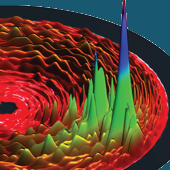Quantum Dynamics of Elementary Reactions in the Gas Phase and on Surfaces
Key Challenges: This research addresses several important dynamics issues in elementary chemical reactions. One of the major obstacles in such studies is the quantum nature of the reactions, where the zero-point energy, mode selectivity, dynamical resonances, non-adiabatic transitions, and tunneling play an important role. The calculations are very challenging because of the large number of quantum states involved, and because of the large number of partial waves. The work required development of new methods and new, highly-efficient codes to calculate the total and state-resolved reaction probabilities. Numerically, the calculations are based on sparse matrix techniques.
Why it Matters: The reactions studied by these very detailed quantum mechanical methods are often at the heart of important processes in combustion and catalysis. Despite the importance of the reactions and despite intense studies in the past many such reactions are still poorly understood, The H + O2 --> OH + O reaction is the most important reaction in hydrocarbon combustion, because of its role in chain branching ignition. Due to increased worldwide interest in renewable energies, hydrogen may become an important fuel in the future and a promising route for producing hydrogen from primary fuels is via steam reforming of methanol. Thus, future studies will concentrate on HO + CO --> H + CO2, which is also the second most important combustion reaction.
Accomplishments: Recent detailed calculations have focused on the O+OH -> H+O2 reaction and have resulted in some of the most intensive quantum scattering calculations to date. This reaction is the reverse of the most important combustion reaction and is also important for ozone destruction. The calculations have shed light on long-standing questions about the statistical nature of the reaction dynamics. The results will serve as a benchmark for more approximate treatments. Codes using OpenMP parallelism for calculating both total and differential cross sections were developed on Franklin and Hopper. This project was a NERSC NISE awardee in 2010. Another study, on the isotope exchange reaction O + O2 --> O2 + O, revealed that the quantum dynamics at the state-to-state level show significant non-statistical behavior.
Principal Investigator: Prof. Hua Guo (University of New Mexico)
More Information: See, for example, Journal of Chemical Physics 133, 054302 (2010, cover story) and Professor Guo's web site.
About NERSC and Berkeley Lab
The National Energy Research Scientific Computing Center (NERSC) is a U.S. Department of Energy Office of Science User Facility that serves as the primary high performance computing center for scientific research sponsored by the Office of Science. Located at Lawrence Berkeley National Laboratory, NERSC serves almost 10,000 scientists at national laboratories and universities researching a wide range of problems in climate, fusion energy, materials science, physics, chemistry, computational biology, and other disciplines. Berkeley Lab is a DOE national laboratory located in Berkeley, California. It conducts unclassified scientific research and is managed by the University of California for the U.S. Department of Energy. »Learn more about computing sciences at Berkeley Lab.








